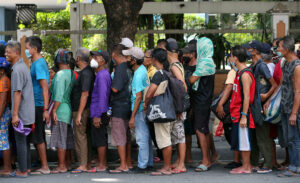Nearly 51M Filipinos face food insecurity — UN report

NEARLY 51 MILLION Filipinos faced moderate or severe food insecurity in 2020 to 2022, the highest number in Southeast Asia, according to a United Nations (UN) report.
The UN’s latest State of Food Security and Nutrition in the World report showed there were 50.9 million people who did not have constant access to adequate food in the Philippines in 2022.
The Philippines had the highest number of moderately or severely food-insecure in the region, accounting for almost half of the 110.9 million total in Southeast Asia.
Myanmar ranked second in the region with 15.8 million, followed by Indonesia (13.4 million), Vietnam (8.7 million), and Cambodia (8.5 million).
However, the prevalence of moderate or severe food security in the total population stood at 44.7% in the Philippines, the second highest in the region after Cambodia (51.1%). It was also much higher than the 16.4% average in Southeast Asia.
The UN report found that around 29.6% of the global population, equivalent to 2.4 billion people, did not have constant access to food, as measured by the prevalence of moderate or severe food insecurity. Of this figure, around 900 million individuals faced severe food insecurity.
The UN report also noted that over 122 million more people are facing hunger in the world since 2019 due to the pandemic, weather shocks and conflicts.
Between 691 million and 783 million people faced hunger in 2022, with a midrange of 735 million. This puts in doubt that the Sustainable Development Goal (SDG) of ending hunger by 2030 will be attained.
“Overall, we need an intense and immediate global effort to rescue the SDG. We must build resilience against the crises and shocks that drive food insecurity — from conflict to climate,” said UN Secretary-General António Guterres in a statement.
The UN report also showed around 5.9 million Filipinos were undernourished in the 2020-2022 period, the second highest in Southeast Asia.
Around 5.2% of the Philippine population were undernourished in 2020-2022.
In Southeast Asia, the number of undernourished people stood at 35.1 million during the 2020-2022 period. The prevalence of undernourishment in the total population in Southeast Asia averaged 5.2%.
Indonesia had the highest number of undernourished people with 16.2 million. The prevalence of undernourishment in Indonesia’s total population stood at 5.9%.
The UN said that most food supply chains are still “highly vulnerable” to external shocks and will require policy interventions to strengthen food systems.
“Urbanization can contribute to longer, more formal and more complex food supply chains, following rising consumer demand and increased regulation of agrifood systems. As cities grow and diets of urban dwellers change, urban populations increasingly must look beyond local production for their food supply,” it added.
Data from the UN showed that traditional food supply chains that are based around subsistence agriculture only account for around 5% of the food economy in Southeast Asia.
The UN recommended initiatives such as awareness-raising campaigns to promote healthy options, using healthier ingredients in government institutes including schools, and making nutritious food more available and accessible in general.
The report also noted other measures to improve food supply chains, such as investing in better and more gender-sensitive wholesale market infrastructure, supporting linkages between small farms and small and medium enterprises, and exploring agroecological innovations and organic agriculture. — L.M.J.C.Jocson




